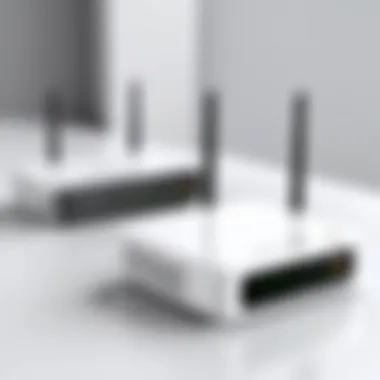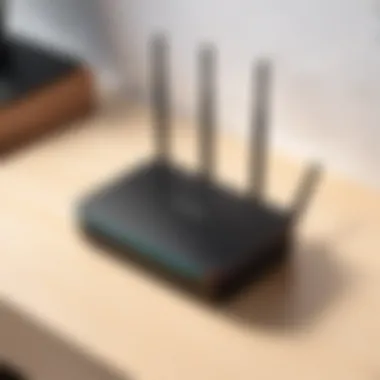Enhancing Connectivity with AC WiFi Range Extenders


Intro
In a world increasingly reliant on digital connectivity, having reliable internet access is crucial. This need extends beyond mere browsing and streaming. As we embrace online activities, be it remote work or gaming, ensuring a strong and stable connection is paramount. AC WiFi range extenders are a valuable solution to enhance wireless coverage in homes and offices. They function by extending the reach of existing WiFi signals, thereby removing dead zones and ensuring coverage across larger areas.
Understanding the mechanics and advantages of AC WiFi range extenders is essential for users looking to improve their network performance. These devices operate on the 802.11ac standard, which is known for its high speed and capacity. With this technology, users can achieve faster data transfer rates, which is especially beneficial in environments with multiple devices.
In the following sections, we will delve into the functionality, advantages, and setup procedures of these extenders, aiming to equip tech-savvy individuals with the knowledge they need to optimize their internet connectivity. The following subsections will provide insights into commonly encountered scenarios and practical tips for effective use. Expect a thorough examination that goes beyond surface-level information.
Prelude to AC WiFi Range Extenders
The expansion of wireless connectivity has transformed our daily activities. Yet, weak signals remain a problem, especially in larger spaces. Here, AC WiFi range extenders provide a crucial solution. They enhance the coverage and strength of WiFi signals, ensuring robustness in your internet connection.
Definition and Purpose
AC WiFi range extenders act as intermediaries between your router and devices located at the edge of your WiFi coverage. They capture the existing signal, amplify it, and broadcast it to areas with little or no connectivity. Consequently, they help overcome dead zones in your home or office. The central purpose of these devices is to provide seamless connectivity, ensuring that you are always connected, whether you are in the next room or far away.
In practical terms, an AC WiFi range extender is particularly useful if you have a large house or multiple floors. Standard routers may struggle to reach distant rooms, leading to frustration for users seeking stable connections for online gaming or video conferencing. By deploying a range extender, you can enhance connectivity not just in one area but throughout your living or workspace.
Difference Between Repeaters and Extenders
It is important to understand the distinction between repeaters and extenders, as these terms are often used interchangeably, yet they denote different functionalities.
- Repeaters: These devices receive the existing WiFi signal, amplify it, and rebroadcast that same signal. While they boost the signal, they may reduce the overall speed due to the nature of their operation.
- Extenders: Unlike repeaters, range extenders create a new network for your devices. They maintain a connection to the router while providing additional coverage, often without the same reduction in speed seen with repeaters.
Choosing between these can impact the quality of your connectivity, which is crucial for various tasks such as high-speed downloading or competitive gaming. Thus, understanding the differences aligns with selecting the appropriate option for your specific needs.
In summary, the AC WiFi range extenders address coverage issues effectively, imparting an essential understanding of how best to utilize these devices can lead to enhanced user experiences.
Key Features of AC WiFi Range Extenders
The significance of AC WiFi range extenders lies in their ability to bolster internet connectivity in larger spaces. In a world that relies heavily on stable internet connections, understanding the key features of these devices can create a more effective and enjoyable digital experience. Here, we delve into the essential attributes that set AC WiFi extenders apart from other devices, focusing on various aspects such as dual-band support, performance metrics, and security features. These elements not only enhance the usability of the extenders but address the needs of modern users seeking reliable internet performance.
Dual-Band Support
Dual-band support is a prevalent feature in many AC WiFi range extenders. Essentially, this allows the extender to operate on two frequency bands: 2.4 GHz and 5 GHz. The 2.4 GHz band provides broader coverage but typically supports lower speeds. In contrast, the 5 GHz band offers much higher speeds with reduced range but is less susceptible to interference.
When selecting an extender, dual-band capability is vital as it enables users to allocate bandwidth more effectively. For instance, devices that demand high-speed internet, such as gaming consoles or smart TVs, can connect via the 5 GHz band, while less demanding devices can remain on the 2.4 GHz band. This setup maintains an optimized performance across the network.
Speed and Performance Metrics
Speed is paramount when considering AC WiFi range extenders. Different models offer varying speed capabilities, often expressed in Mbps (megabits per second). AC extenders generally promise higher maximum speeds when compared to their predecessors, such as N range extenders. When selecting an extender, looking for one that supports the AC standard can greatly enhance your internet experience.
Moreover, performance metrics often include latency and data throughput rates. Lower latency is crucial for applications like online gaming or video conferencing, where delays can disrupt communication. As such, carefully examining these performance indicators can help in choosing a product that not only meets but exceeds your essential requirements.
Security Features
In this digital age, security cannot be overlooked. AC WiFi range extenders come equipped with various security protocols to protect users from unauthorized access. The most common of these is WPA2, which encrypts user data and prevents intrusions.


Many modern extenders also incorporate features like guest networks. This allows visitors to connect without exposing the main network, providing an additional layer of security. So when purchasing an AC WiFi extender, ensure that it includes robust security measures, as this will protect both your data and devices from potential threats.
Design and Aesthetic Considerations
Design plays a pivotal role in the choice of AC WiFi range extenders. While functionality is key, many users prefer devices that blend seamlessly with their home or office decor. Sleek, modern designs have become more common, and manufacturers are increasingly aware of this trend.
Considerations may include size, color, and the ability to mount the extender on a wall. A discreet device can be more visually appealing and help maintain the intended aesthetic of the space. Therefore, it is advisable to look for an extender that matches your environmental preferences while still offering effective performance.
"Choosing a WiFi range extender is not just about features but also about compatibility with your lifestyle and space."
By assessing these key features—dual-band support, speed and performance metrics, security features, and design considerations—you can make an informed decision on the ideal AC WiFi range extender to enhance your connectivity.
How AC WiFi Range Extenders Work
Understanding how AC WiFi range extenders function is crucial for appreciating their role in enhancing network coverage. By grasping the technical underpinnings of these devices, users can effectively troubleshoot issues and optimize performance. Range extenders are designed to boost the existing wireless signal, thereby expanding its reach and improving connectivity in areas otherwise neglected by the primary router.
Signal Amplification Techniques
Signal amplification is the core function of AC WiFi range extenders. The basic principle involves receiving the existing WiFi signal and amplifying it to cover larger spaces.
- Reception of WiFi Signals: The extender picks up the signal from the router. This is typically done through its antennas, which can be internal or external.
- Amplification: Once the signal is captured, the extender processes it. This is achieved using various hardware components, such as amplifiers. These components ensure that the initial signal, which might be weak and unstable, gets strengthened.
- Redistribution: After amplification, the range extender then broadcasts the strengthened signal further into areas where the original signal was weak. This technique considerably minimizes dead spots in homes or offices.
- Channel Selection: Advanced extenders intelligently select the best channel to transmit data. This feature helps minimize interference from other devices, ensuring a reliable connection.
Through these techniques, AC WiFi range extenders enable smoother, uninterrupted internet access. They make it possible for multiple devices to connect without noticeable performance degradation, which is particularly beneficial for gaming or streaming environments.
"AC WiFi range extenders are essential for extending the boundaries of wireless networks, ensuring that you stay connected where you need it most."
Communication Protocols
Communication protocols dictate the manner in which devices connect and share information. In the context of AC WiFi range extenders, these protocols play a significant role in facilitating effective and efficient data transmission. Two notable protocols are 802.11ac and 802.11n.
- 802.11ac: This is a newer standard that supports higher data rates and more devices.
- 802.11n: While older, this protocol is still relevant in many setups.
- Features: Offers dual-band capability, with separate channels for 2.4GHz and 5GHz frequencies.
- Benefit: This provides greater flexibility in handling multiple types of traffic, such as streaming and online gaming.
- Features: Supports multiple-input multiple-output (MIMO) technology, which allows multiple data streams simultaneously.
- Benefit: This can improve coverage by allowing greater throughput even in congested networks.
Proper understanding of these communication protocols helps users make informed choices regarding their network setup. It can also aid in addressing performance issues by ensuring that the extender aligns well with deployed devices in the environment.
In summary, Comprehending how AC WiFi range extenders work forms the foundation for maximizing their utility. By leveraging knowledge of signal amplification techniques and communication protocols, users can not only enhance their internet connectivity but also achieve a more stable and satisfying online experience.
Choosing the Right AC WiFi Range Extender
Choosing the appropriate AC WiFi range extender is crucial for enhancing your wireless network coverage effectively. Not all extenders are created equal; various factors contribute to their performance and efficiency. A well-chosen extender can significantly improve signal strength and connectivity across multiple devices in your home or office, making this decision a fundamental part of network optimization.
Factors to Consider
Coverage Area
The coverage area is one of the first considerations when selecting a WiFi range extender. This aspect directly influences the effectiveness of the device. A coverage area that accurately matches your needs ensures that the network reaches every corner of your space.


For instance, if your home has multiple floors or is particularly large, an extender with a broader coverage area is advantageous. Choosing a model that indicates its effective range in square feet or meters helps evaluate its suitability. The unique feature here is that a wider coverage area reduces the chances of dead zones where signal loss is prevalent. However, be cautious; extenders with broader coverage can sometimes have slower speeds at the edges of this range.
Internet Speed Requirements
Internet speed requirements are another significant element affecting your choice. A range extender must support the internet speed provided by your service provider to maintain optimal performance. When selecting an extender, look for compatibility with your current internet plan.
A key characteristic of speed requirements is that many extenders offer dual-band capabilities, supporting both 2.4 GHz and 5 GHz frequencies. This functionality ensures that multiple devices can connect without significant speed degradation. The unique feature here is the ability to prioritize the band that offers the fastest connectivity based on device and distance from the extender. However, if your extender does not support adequate speeds for the number of devices connected, poor performance will result.
Device Compatibility
Device compatibility is essential when choosing an AC WiFi range extender. Not all extenders will work seamlessly with every device. Ensuring that the range extender is compatible with your router and all the devices you intend to connect is vital.
Many modern extenders support various protocols like 802.11ac and backward compatibility with older protocols. This characteristic allows for a broader range of devices to connect without issues. The unique feature of compatibility is its impact on the overall user experience. If an extender cannot effectively interact with your devices, it will lead to frustrating connection issues. However, opting for a model that lacks device compatibility can limit its usefulness significantly.
Popular Brands and Models
Several brands stand out in the market for their reliability and performance in the WiFi range extender category. Some popular choices include NETGEAR, TP-Link, and Linksys. Each brand offers various models, often specifically labeled based on coverage area, speed capabilities, and compatibility features. Researching brand reputation and user reviews can lead to informed decisions, ensuring that the extender you choose aligns well with your requirements.
Installation and Configuration of AC WiFi Range Extenders
The installation and configuration of AC WiFi range extenders is a crucial step in enhancing wireless network coverage. A properly set up range extender can significantly eliminate dead spots, giving you seamless internet access across your entire space. Choosing the right placement for your extender can optimize WiFi connectivity. Planning this step can save time and frustration.
Moreover, understanding how to configure your device can help you effectively utilize its features. Effective installation means users can enjoy improved performance, ensuring that all devices maintain strong connections. The overall aim here is to make the process smooth, addressing common pitfalls and simplifying the entire setup.
Step-by-Step Setup Guide
- Select the Right Location: The first step is to find a suitable spot for your AC WiFi range extender. Ideally, this should be halfway between your router and the area lacking coverage. Avoid placing it near thick walls or electronic devices that may cause interference.
- Plug in the Extender: Use a power outlet within range of your WiFi signal. Plug the extender and wait for it to power up.
- Connect to Your Device: Using a computer, tablet, or smartphone, connect to the extender's default WiFi network. This network's name is usually found on a sticker on the device.
- Access the Setup Interface: Open a web browser and enter the IP address mentioned in the manual to access the setup page. You'll be prompted to log in. Default login credentials are often admin/admin or admin/password, but this can vary.
- Choose Your WiFi Network: Once logged in, select your existing WiFi network from the list. You will need to enter your WiFi password to link the extender to your main network.
- Customize Settings: At this point, you can also modify the extender's settings to suit your needs. For instance, you can change the SSID or set a different password for the extended network.
- Finish Setup: Save the changes and allow the extender to restart. Upon completion, re-connect to your device using either the original WiFi network or the new SSID you've created.
- Test the Connection: Finally, move to the areas you want to cover and test the connection. Ensure the signals are strong, and adjust placement if necessary.
Common Installation Errors to Avoid
Setting up AC WiFi range extenders can come with its share of challenges. Here are some common issues:
- Poor Placement: Don't place extenders too far from the router. If the extender does not receive a good signal, it will not boost the WiFi effectively.
- Neglecting Firmware Updates: Many users skip firmware updates, but outdated software can lead to security vulnerabilities and performance issues. Regular updates ensure optimal performance.
- Ignoring Compatibility: Ensure that the extender is compatible with your current router. Incompatible devices may lead to connectivity challenges or even complete failures.
- Using Default Passwords: For security reasons, change the default login credentials. Keeping them unchanged makes networks vulnerable to unauthorized access.
- Overloading the Extender: Each extender has a limit on how many devices it can support. Connecting too many devices may lead to a decrease in performance.
By carefully following the setup instructions and avoiding common mistakes, you can enhance your WiFi coverage successfully.
Optimizing Performance of WiFi Range Extenders
Optimizing the performance of WiFi range extenders is a crucial aspect of ensuring robust and efficient internet connectivity. If a range extender is not optimized, you may not experience the performance benefit that the device is capable of providing. Several factors contribute to how well your extender works. This includes placement in your home or office, the need for regular firmware updates, and proper maintenance. Understanding these elements enhances the overall experience, especially for users who rely heavily on stable connections for work or gaming.
Signal Placement Strategies
The placement of your WiFi range extender can significantly affect its performance. Here are some key considerations for finding the best location:
- Central Location: Position the extender in a central spot relative to the router and the area where improved coverage is required. This will maximize the signal coverage into weak areas.
- Avoid Obstacles: Walls, furniture and other large objects can block signals. Try to keep the path between the router and the extender as clear as possible.
- Height Matters: Elevating the extender can improve signal reach. Mount it on a shelf or the wall to reduce interference from furniture.
- Test Different Locations: Don’t hesitate to move the extender. Use a mobile device to test the signal strength in various locations until you find the optimal spot.
By applying these strategies, you may see noticeable improvements in signal strength and internet speed throughout the space.


Firmware Updates and Maintenance
Keeping your device firmware updated is vital for maintaining optimal performance. Manufacturers regularly release updates to fix bugs, improve performance, and enhance security. Here’s how to handle updates and maintenance effectively:
- Regularly Check for Updates: Most extenders have a built-in feature to check for updates. Keep an eye on the manufacturer’s website or the device interface for notifications.
- Schedule Updates: Plan for updates around times you typically do not need internet access. This ensures minimal disruption to your daily usage.
- Periodical Reboots: Just like a regular router, range extenders benefit from being rebooted occasionally. This can clear any minor issues impacting performance.
- Monitor Device Performance: Use tools available in the device settings to monitor performance metrics. This can help identify if the device is underperforming or if an update is needed.
As you can see, the effective management of both signal placement and firmware updates is essential in optimizing the performance of WiFi range extenders. By following these guidelines, users can ensure that their devices operate at peak efficiency, providing the best possible internet connectivity.
Troubleshooting Common Issues
Troubleshooting common issues with AC WiFi range extenders is a critical aspect of ensuring optimal network performance. As users increasingly rely on stable and fast connections for various tasks, ranging from online gaming to streaming, addressing these technical difficulties is paramount. By understanding how to diagnose and resolve potential problems, users can maintain consistent connectivity and maximize the benefits of their extenders.
Connection Problems
Connection problems are among the most prevalent issues faced by users of AC WiFi range extenders. These issues can manifest as dropped connections or an inability to connect to the extender itself. Multiple factors can contribute to connection problems, including improper placement of the extender, outdated firmware, or incorrect network credentials.
To effectively resolve connection issues, begin with checking the placement of the extender. It is essential that the extender is located within range of the primary router’s signal. If the extender is too far away, it won't receive a strong enough signal to relay effectively. Additionally, ensure that the extender is powered on and that its lights indicate a healthy connection.
Another potential fix is to update the firmware. Manufacturers often release updates that improve functionality and resolve known issues. Visit the manufacturer's website or use the mobile app, if available, to check for updates. Finally, verify that the correct network credentials have been inputted while setting up the extender. Incorrect passwords will naturally prevent connections from being established.
Slow Performance Issues
Slow performance of AC WiFi range extenders can also frustrate users significantly. Many factors can lead to reduced speeds, including high interference from neighboring networks, inadequate bandwidth support, or the extent of the coverage area demanded. Slow speeds can render even the fastest internet plan unusable, leading to lags during crucial tasks.
To troubleshoot slow performance, first assess the network congestion. If multiple devices are connected and actively using bandwidth, speeds may naturally decline. Disconnect devices that are not in use and see if performance improves. Monitoring the the WiFi channel used can also be a beneficial step. Changing to a less crowded channel can enhance speed by reducing interference from other networks. Finally, consider upgrading to an extender model with better specifications that can handle higher speeds.
Interference from Other Devices
Interference from other electronic devices can significantly impact the performance of AC WiFi range extenders. Common household devices, such as microwaves and cordless phones, operate on similar frequencies which can disrupt the wireless signal. Understanding how to identify and mitigate this interference is essential for maintaining a stable connection.
To combat this issue, begin by relocating the extender away from potential sources of interference. Ideally, position the device in open areas away from thick walls and electronic appliances. Another option is to switch to using dual-band technology. Most modern extenders offer both 2.4 GHz and 5 GHz bands, with the latter being less prone to interference. You can also make use of an Ethernet connection for devices that require stable connections, circumventing wireless hiccups altogether.
"A strong and stable connection can be achieved through proper placement, ongoing maintenance, and smart usage of your AC WiFi range extender."
By considering these common issues and their solutions, AC WiFi range extender users can enhance their network experience significantly.
Closure
In this article, we have thoroughly examined the functionality and advantages of AC WiFi range extenders. Understanding their benefits not only helps in making informed decisions but also enhances overall internet connectivity in various environments. The discussion has focused on how these devices improve coverage, address common connectivity issues, and offer flexibility in both home and office settings.
Summary of Benefits
The primary benefits of AC WiFi range extenders include:
- Extended Coverage: They effectively bridge the gap in areas where the main router signal is weak or absent. This is crucial for larger homes or buildings where consistent connectivity is necessary.
- Improved Internet Speed: By strategically placing extenders, users can experience significant enhancements in data speed, leading to smoother streaming, gaming, and browsing experiences.
- Ease of Use: Installation and setup are typically straightforward, allowing users to quickly enhance their networks without professional help.
- Cost-Effective Solution: Investing in a range extender is often more economical than upgrading to a more powerful router or setting up a mesh network.
As technology evolves, these benefits align with user needs, particularly for esports enthusiasts and technology aficionados seeking reliable internet access.
Future Considerations
Looking ahead, several considerations will shape the use and development of AC WiFi range extenders.
- Technological Advancements: Future models may incorporate more advanced technology, such as AI-driven connectivity management, which could optimize performance based on user behavior patterns.
- Integration with Smart Home Devices: As the smart home ecosystem expands, the compatibility of range extenders with smart devices will become increasingly important.
- Increasing Demand for High Bandwidth: With the rise of 4K streaming and online gaming, devices will need to support higher throughput to meet user expectations.
- Security Enhancements: As cyber threats evolve, ongoing improvements in security protocols and features in range extenders will be vital to ensure a safe online experience.
By understanding these aspects, consumers can better prepare for the future landscape of internet connectivity, ensuring they remain at the forefront of technological advancements.



